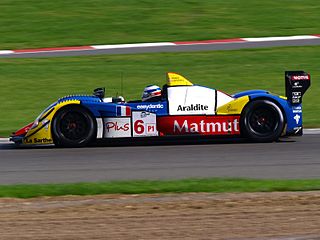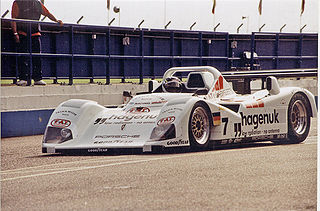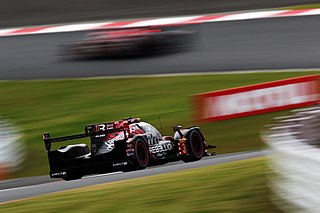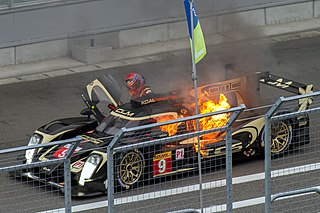
Roland Walter Ratzenberger was an Austrian racing driver who raced in various categories of motorsport, including British Formula 3000, Japanese Formula 3000 and Formula One. Having had sporadic success throughout the lower formulas, Ratzenberger managed to secure an F1 seat in 1994 for the new Simtek team, at the unusually late age of 33. He was killed in a crash during qualifying for the 1994 San Marino Grand Prix just three races into his F1 career. The weekend became notorious for also seeing the death of Ayrton Senna, a three time world champion, during the race the following day.

David Philip Brabham is an Australian professional racing driver and one of the most successful and experienced specialists in sports car racing. He has won three international Sports Car series and is one of four Australians to have won the Le Mans 24 Hour sports car race, winning the event in 2009. Brabham won the American Le Mans Series in 2009 and 2010. He also competed in Formula One, racing for the Brabham and Simtek teams in 1990 and 1994, respectively. Brabham is the youngest son of three-time Formula One world champion Sir Jack Brabham, brother to Geoff Brabham and Gary Brabham. He is also brother-in-law to Mike Thackwell, father to Sam Brabham and uncle to Matthew Brabham.

A Le Mans Prototype (LMP) is the type of sports prototype race car previously and currently used in various races and championships, including the 24 Hours of Le Mans, FIA World Endurance Championship, IMSA SportsCar Championship, European Le Mans Series and Asian Le Mans Series. Le Mans Prototypes were created by the Automobile Club de l'Ouest (ACO). The technical requirements for an LMP include bodywork covering all mechanical elements of the car. Currently, there are two classes within Le Mans Prototypes, designated LMP2, and LMP3.

The 1999 24 Hours of Le Mans was the 67th 24 Hours of Le Mans, and took place on 12 and 13 June 1999. The race had a large number of entries in the fastest Le Mans Prototype classes, with Audi, BMW, Ferrari, Lola Cars, Mercedes-Benz, Nissan, Panoz, Riley & Scott, and Toyota all represented. The BMW V12 LMR of Yannick Dalmas, Pierluigi Martini, and Joachim Winkelhock won overall, with their car's reliability and fuel economy allowing them to beat their faster rivals.

The 1996 24 Hours of Le Mans was the 64th Grand Prix of Endurance, and took place on 15 and 16 June 1996. It was won by a Tom Walkinshaw-Porsche prototype run by Joest Racing with drivers Davy Jones, Manuel Reuter and Le Mans rookie Alexander Wurz completing 354 laps. While not being the fastest car on track, it hit the front in the first hour and aside from several pit-stop overlaps, was never headed as other teams hit mechanical troubles during the race. This was Reuter's second Le Mans victory, and the first for Jones and Wurz, who, at 22 years old, became the youngest ever Le Mans overall winner.

The 1994 24 Hours of Le Mans was the 62nd Grand Prix of Endurance, and took place on 18 and 19 June 1994.

The 1993 24 Hours of Le Mans was the 61st Grand Prix of Endurance, and took place on 19 and 20 June 1993.

The Toyota GT-One is a racing car initially developed for Group GT1 rules, but later adapted into an LMGTP car. It raced in the 1998 and 1999 24 Hours of Le Mans.

Courage Compétition was a racing team and chassis constructor company now owned by Oreca, based in Le Mans, France near the Circuit de la Sarthe. It was founded by Yves Courage, a French race driver who ran hillclimbs before founding the company. Following the purchase of Courage by Oreca in 2007, Yves Courage has refounded the company as Courage Technology in 2010, attempting to develop electric racing cars.

The Porsche WSC-95 was a Le Mans Prototype originally built by Tom Walkinshaw Racing. It was modified by Porsche from the original Group C Jaguar XJR-14 from which it derived, and run by Joest Racing. Originally intended to race in the IMSA World Sportscar Championship, the WSC-95 saw very little race action even though it won the 24 Hours of Le Mans in both 1996 and 1997 without being acknowledged as a factory supported project. It was later upgraded to the Porsche LMP1-98 before being retired. Only two cars were ever built.

SARD Corporation is a Japanese tuning company and racing team from Toyota, Aichi, mainly competing in the Super GT series and specializing in Toyota tuning parts.

OAK Racing is an endurance racing team specialising in sports prototypes based in Le Mans, France. In 2013 it won the 24 Hours of Le Mans in LMP2 class and the 2013 FIA WEC World Champion drivers and teams on LMP2 class.

The 80th 24 Hours of Le Mans was a 24-hour automobile endurance race for teams of three drivers each entering Le Mans Prototype and Le Mans Grand Touring Endurance cars held from 16 to 17 June 2012 at the Circuit de la Sarthe close to Le Mans, France before 240,000 spectators. It was the 80th running of the event, as organised by the automotive group, the Automobile Club de l'Ouest (ACO) since 1923. The race was the third round of the 2012 FIA World Endurance Championship, with 30 of the race's 56 entries contesting the championship. A test day was held two weeks prior to the race on 3 June.

Rebellion Racing was a Swiss racing team that competed in endurance racing. The team competed in the 2011 Intercontinental Le Mans Cup season and won the LMP1 teams' title in the 2011 Le Mans Series season. The team started as an association between Speedy Racing and Sebah Racing, which began in 2008. Rebellion Racing's last team principal was Alexandre Pesci and the team manager was Bart Hayden.

The 60th Annual Mobil 1 Twelve Hours of Sebring was the 60th running of the 12 Hours of Sebring, an auto race held at the Sebring International Raceway from 15–17 March 2012. The race served as the opening round for both the inaugural FIA World Endurance Championship and American Le Mans Series seasons. The field of 64 entries was divided into nine classes: five from the American Le Mans Series and four from the World Endurance Championship.
The Debora LMP200 was a Le Mans Prototype, built by Debora in 2001 for use in the European Le Mans Series. Initially fitted with a 3.2-litre BMW straight-six engine, it was refitted with a 3-litre BMW straight-six in 2002, and then a 3.4-litre Mader-BMW straight-six in 2003. One car is known to have been built. The LMP200 was used by Didier Bonnet Racing when they won the European Le Mans Series in 2001.

The CLM P1/01, renamed ENSO CLM P1/01 in 2017, is a sports prototype racing car built for Lotus Racing in 2014. The Lotus team entered the last five rounds of the World Endurance championship in 2014, but later took name as the Austrian based team ByKolles Racing. It is designed to meet the 2014 LMP1-L regulations for Le Mans Prototypes in the FIA World Endurance Championship as well as at the 24 Hours of Le Mans. The P1/01 debuted at the 2014 6 Hours of Circuit of the Americas, round four of the FIA World Endurance Championship.

The 85th 24 Hours of Le Mans was a 24-hour automobile endurance race held for teams of three drivers each entering Le Mans Prototype (LMP) and Le Mans Grand Touring Endurance (LMGTE) cars from 17 to 18 June 2017 at the Circuit de la Sarthe, near Le Mans before 258,500 spectators. The race's 85th running, organised by the Automobile Club de l'Ouest, was the third of nine rounds in the 2017 FIA World Endurance Championship.

The 87th 24 Hours of Le Mans was an 24 hour automobile endurance race for Le Mans Prototype and Le Mans Grand Touring Endurance cars entered by teams of three drivers each held from 15 to 16 June 2019 at the Circuit de la Sarthe, close to Le Mans, France before approximately 252,500 people. It was the 87th running of the event, as organised by the automotive group, the Automobile Club de l'Ouest (ACO) since 1923. The round was the last race in the 2018–19 FIA World Endurance Championship and the second time in the season that the series had visited Le Mans. A test day was held two weeks prior to the race on 2 June.

The Courage C30, also known as the Courage C30LM, was a Group C2 sports prototype, designed, developed and built by French manufacturer Courage in 1993. It famously contested in the 1993 24 Hours of Le Mans, with drivers Derek Bell and Pierre Yver finishing in 10th and 11th place, respectively.















